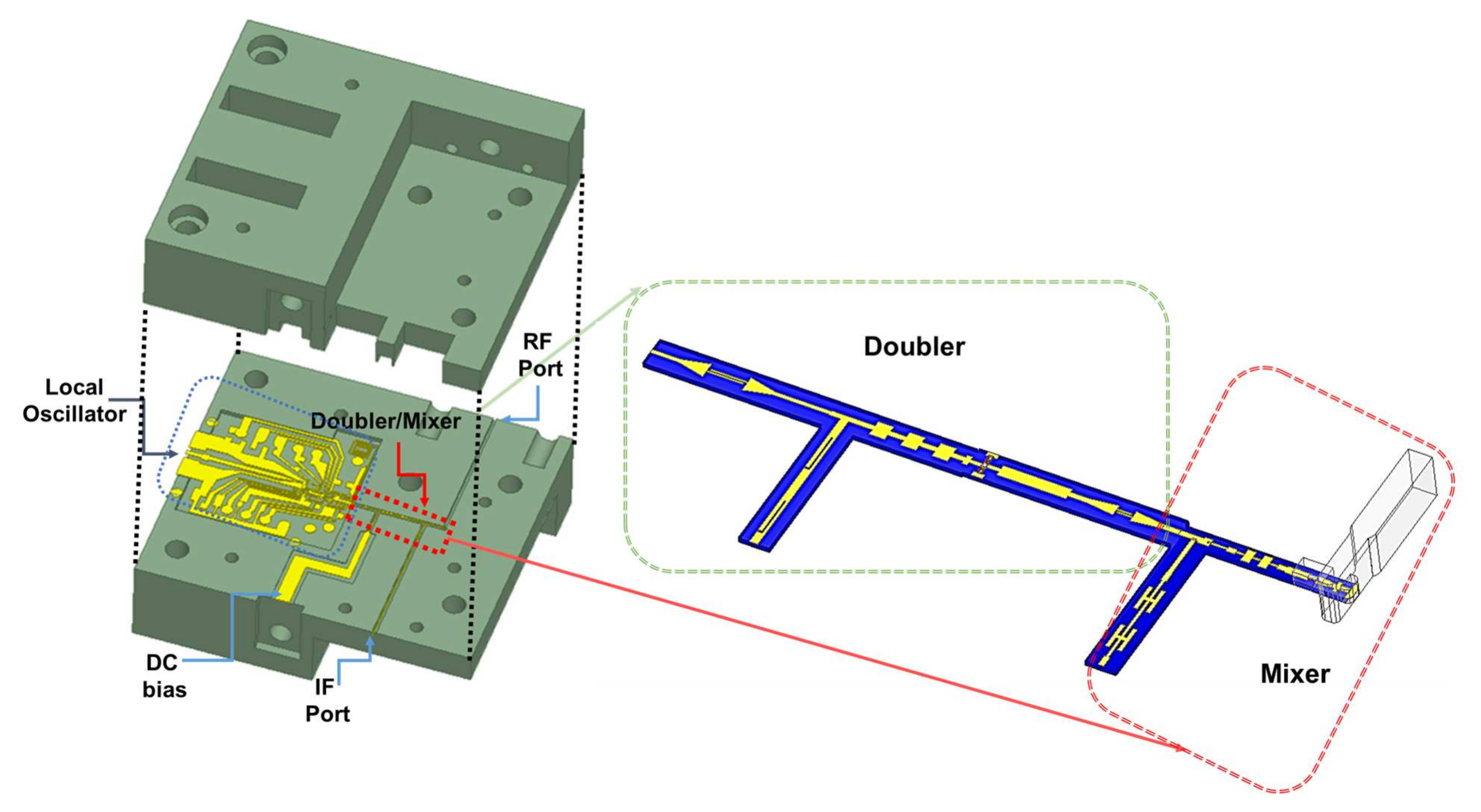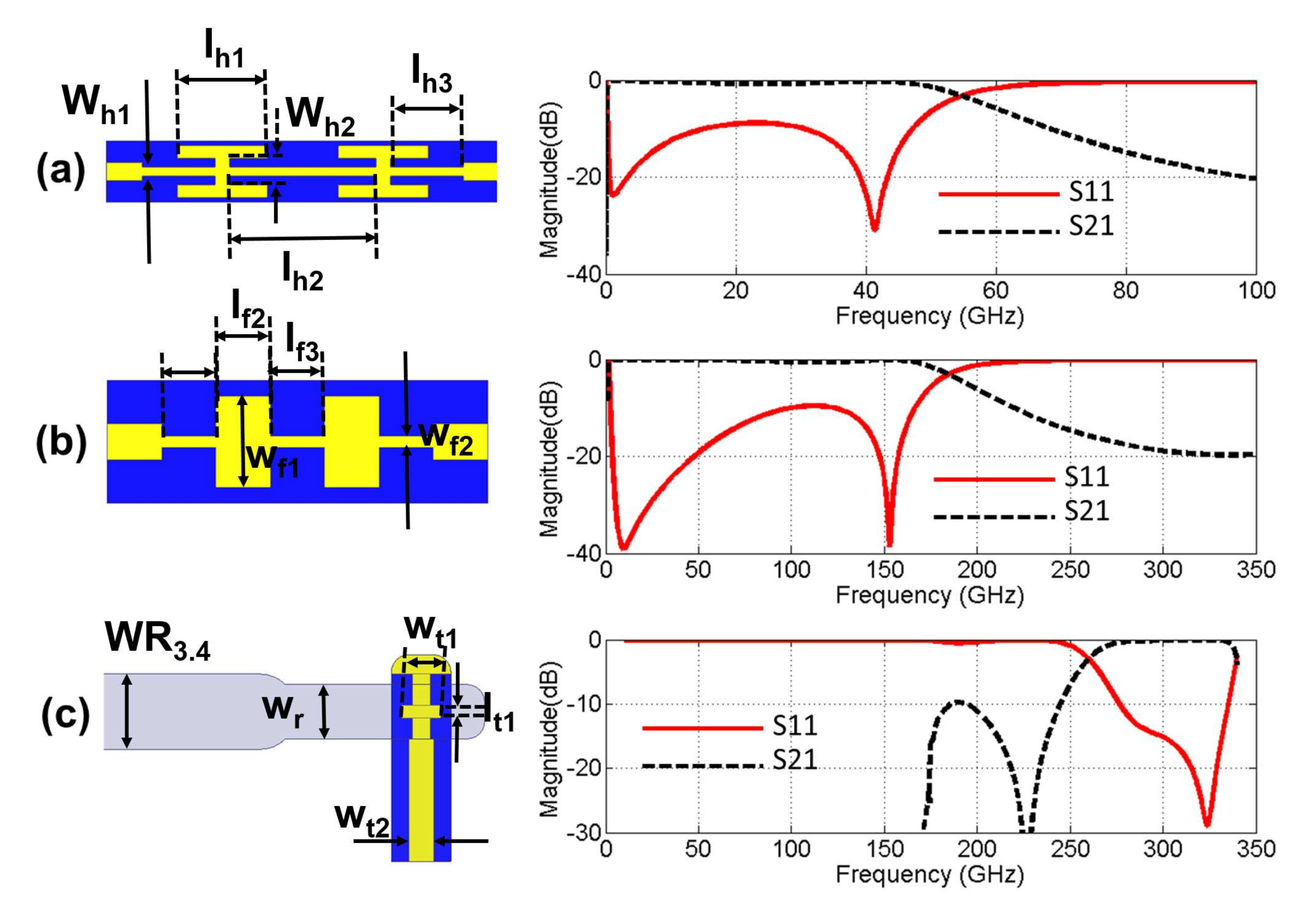Design of 300 GHz Combined Doubler/Subharmonic Mixer Based on Schottky Diodes with Integrated MMIC Based Local Oscillator
Abstract
:1. Introduction
2. Design
2.1. Passive Circuit Design
2.2. Harmonic Balance
3. Manufacturing and Experimental Validation
4. Conclusions
Author Contributions
Funding
Conflicts of Interest
Abbreviations
| CL | Conversion Loss |
| COC | Cyclic Olefin Copolymer |
| COTS | Commercial Off-The-Shelf |
| DSB | Double Side Band |
| ENT | Equivalent Noise Temperature |
| IF | Intermediate Frequency |
| LO | Local Oscillator |
| MMIC | Monolithic microwave and integrated circuits |
| PLL | Phase-Locked Loop |
| UTC-PD | Unitravelling Carrier Photodiodes |
| VCO | Voltage Controlled Oscillator |
References
- Nagatsuma, T.; Ducournau, G.; Renaud, C.C. Advances in terahertz communications accelerated by photonics. Nat. Photonics 2016, 10, 371–379. [Google Scholar] [CrossRef]
- Nagatsuma, T. Generating Millimeter and Terahertz Waves. IEEE Microw. Mag. 2009, 10, 64–74. [Google Scholar] [CrossRef]
- Huggard, P.H.; Ellison, B.N.; Alderman, B.; Warner, J.E.J. 1.55 μm photomixer sources for mm-wave heterodyne detection and frequency conversion with Schottky diodes. In Proceedings of the Digest of the LEOS Summer Topical Meetings, San Diego, CA, USA, 25–27 July 2005; pp. 105–106. [Google Scholar] [CrossRef]
- Ali, M.; Pérez-Escudero, J.M.; Guzmán-Martínez, R.C.; Lo, M.-C.; Ederra, I.; Gonzalo, R.; García-Muñoz, L.E.; Santamaría, G.; Segovia-Vargas, D.; van Dijk, F.; et al. 300 GHz Optoelectronic Transmitter Combining Integrated Photonics and Electronic Multipliers for Wireless Communication. Photonics 2019, 6, 35. [Google Scholar] [CrossRef] [Green Version]
- Torres-García, A.E.; Pérez-Escudero, J.M.; Teniente, J.; Gonzalo, R.; Ederra, I. Silicon Integrated Subharmonic Mixer on a Photonic-Crystal Platform. IEEE Trans. Terahertz Sci. Technol. 2020. [Google Scholar] [CrossRef]
- Sobis, P. Advanced Schottky Diode Receiver Front-Ends for Terahertz Applications; Chalmers University of Technology: Gothenburg, Sweden, 2011. [Google Scholar]
- Zhang, Y.; Zhao, W.; Wang, Y.; Ren, T.; Chen, Y. A 220 GHz subharmonic mixer based on schottky diodes with an accurate terahertz diode model. Microw. Opt. Technol. Lett. 2016, 58, 2311–2316. [Google Scholar] [CrossRef]
- Wang, H. Conception et Modelisation de Circuits Monolithiques a Diode Schottky sur Substrat GaAs aux Longueurs d’onde Millimetriques et Submillimetriques pour les Recepteurs Heterdodynes Multi-Pixels Embarques sur Satellites et Dedies a L’Aeronomie ou la Planetologie. Ph.D. Thesis, Observatoire de Paris, Paris, France, 2009. [Google Scholar]
- Thomas, B.; Maestrini, A.; Beaudin, G. A low-noise fixed-tuned 300-360-GHz sub-harmonic mixer using planar Schottky diodes. IEEE Microw. Wireless Comp. Lett. 2005, 15, 865–867. [Google Scholar] [CrossRef]
- Maestrojuan, I.; Ederra, I.; Gonzalo, R. Fourth-Harmonic Schottky Diode Mixer Development at Sub-Millimeter Frequencies. IEEE Trans. Terahertz Sci. Technol. 2015, 5, 518–520. [Google Scholar] [CrossRef]
- Hasch, J.; Topak, E.; Schnabel, R.; Zwick, T.; Weigel, R.; Waldschmidt, C. Millimeter-Wave Technology for Automotive Radar Sensors in the 77 GHz Frequency Band. IEEE Trans. Microw. Theory Tech. 2012, 60, 845–860. [Google Scholar] [CrossRef]
- Yujiri, L.; Shoucri, M.; Moffa, P. Passive Millimeter-Wave Imaging. IEEE Microw. Mag. 2003, 4, 39–50. [Google Scholar] [CrossRef] [Green Version]
- Panzner, B. In-band wireless backhaul for 5G millimeter wave cellular communications-interactive live demo. In Proceedings of the IEEE Conference on Computer Communications Workshops Hong Kong, Hong Kong, China, 26 April–1 May 2015; pp. 21–22. [Google Scholar]
- Golcuk, F.; Kanar, T.; Rebeiz, G.M. A 90–100 GHz 4x4 SiGe BiCMOS Polarimetric Transmit/Receive Phased Array with Simultaneous Receive-Beams Capabilities. IEEE Trans. Microw. Theory Tech. 2013, 61, 3099–3114. [Google Scholar] [CrossRef]
- Folster, F.; Rohling, H.; Lubbert, U. An Automotive Radar Network Based on 77 GHz FMCW sensors. In Proceedings of the IEEE International Radar Conference, Arlington, VA, USA, 9–12 May 2005; pp. 871–876. [Google Scholar]
- Sheen, D.M.; McMakin, D.L.; Hall, T.E. Three-dimensional millimeter-wave imaging for concealed weapon detection. IEEE Trans. Microw. Theory Tech. 2001, 49, 1581–1592. [Google Scholar] [CrossRef]
- Torres-García, A.E.; Ederra, I.; Gonzalo, R. Implementation of a THz quasi-spiral antenna for THz-IR detector. In Proceedings of the 11th European Conference on Antennas and Propagation (EUCAP), Paris, France, 19–24 March 2017; pp. 2526–2529. [Google Scholar]
- Edholm’s Law of Bandwidth. Available online: http://spectrum.ieee.org/telecom/wireless/edholms-law-of-bandwidth (accessed on 9 May 2017).
- Federici, J.; Moeller, L. Review of terahertz and subterahertz wireless communications. J. Appl. Phys. 2010, 107, 13–26. [Google Scholar] [CrossRef] [Green Version]
- Thomas, B.; Alderman, B.; Matheson, D.; de Maagt, P. A Combined 380 GHz Mixer/Doubler Circuit Based on Planar Schottky Diodes. IEEE Microw. Wirel. Compon. Lett. 2008, 18, 353–355. [Google Scholar] [CrossRef]
- Treuttel, J.; Maestrini, A.; Alderman, B.; Wang, H.; de Maagt, P. Design of a combined tripler-subharmonic mixer at 330 GHz for multipixel application using European Schottky diodes. In Proceedings of the 21st International Symposium on Space Terahertz and Technology, Oxford, UK, 23–25 March 2010. [Google Scholar]
- Ederra, I.; Azcona, L.; Alderman, B.E.J.; Laisné, A.; Gonzalo, R.; Mann, C.M.; Matheson, D.N.; de Maagt, P. A 250 GHz Sub-Harmonic Mixer Design Using EBG Technology. IEEE Trans. Antennas Propag. 2007, 55, 2974–2982. [Google Scholar] [CrossRef]
- Khromova, I.; Gonzalo, R.; Ederra, I.; Delhote, N.; Baillargeat, D.; Murk, A.; Alderman, B.; de Maagt, P. Subharmonic Mixer Based on EBG Technology. IEEE Trans. Terahertz Sci. Technol. 2013, 3, 838–845. [Google Scholar] [CrossRef]
- Reck, T.; Jung-Kubiak, C.; Siles, J.V.; Lee, C.; Lin, R.; Chattopadhyay, G.; Mehdi, I.; Cooper, K. A Silicon Micromachined Eight-Pixel Transceiver Array for Submillimeter-Wave Radar. IEEE Trans. Terahertz Sci. Technol. 2015, 5, 197–206. [Google Scholar] [CrossRef]
- Thomas, B.; Lee, C.; Peralta, A.; Gill, J.; Chattopadhyay, G.; Sin, S.; Lin, R.; Mehdi, I. A 530–600 GHz Silicon Micro-machined Integrated Receiver Using GaAs MMIC Membrane Planar Schottky Diodes. In Proceedings of the 21st International Symposium on Space Terahertz Technology, Oxford, UK, 23–25 March 2010. [Google Scholar]
- Maestrini, A.; Thomas, B.; Wang, H.; Jung, C.; Treuttel, J.; Jin, Y.; Chattopadhyay, G.; Mehdi, I.; Beaudin, G. Schottky diode-based terahertz frequency multipliers and mixers. C. R. Phys. 2010, 11, 480–495. [Google Scholar] [CrossRef]
- Wang, H.; Maestrini, A.; Thomas, B.; Alderman, B.; Beaudin, G. Development of a Two-Pixel Integrated Heterodyne Schottky Diode Receiver at 183 GHz. In Proceedings of the 9th International Symposium on Space Terahertz Technology, Groningen, The Netherlands, 28–30 April 2008. [Google Scholar]
- Automotive. Available online: https://www.qorvo.com/applications/automotive (accessed on 4 August 2017).
- Maestrojuan, I.; Palacios, I.; Ederra, I.; Gonzalo, R. Use of COC substrates for millimeter-wave devices. Microw. Opt. Technol. Lett. 2014, 57, 371–377. [Google Scholar] [CrossRef]
- Rebollo, A. Development of an Auto-Calibrated Receiver in Planar Technology at Millimetre-Wave Frequencies. Ph.D. Thesis, Universidad Pública de Navarra, Pamplona, Spain, 2015. [Google Scholar]
- Sengupta, A.; Bandyopadhyay, A.; Bowden, B.F.; Harrington, J.A.; Federici, J.F. Characterisation of olefin copolymers using tera-hertz spectroscopy. Electron. Lett. 2006, 42, 1477–1479. [Google Scholar] [CrossRef]
- Chen, Z.; Wang, H.; Alderman, B.; Huggard, P.; Zhang, B.; Fan, Y. 190 GHz high power input frequency doubler based on Schottky diodes and AlN substrate. IEICE Electron. Express 2016. [Google Scholar] [CrossRef] [Green Version]
- Zhao, C. Modelling and Characterisation of a Broadband 85/170 GHz Schottky Varactor Frequency Doubler. Ph.D. Thesis, Chalmers University of Technology, Gothenburg, Sweden, 2011. [Google Scholar]
- Mehdi, I.; Marazita, S.M. Improved 240-GHz subharmonically pumped planar Schottky diode mixers for space-borne applications. IEEE Trans. Microw. Theory Tech. 1998, 46, 2036–2042. [Google Scholar] [CrossRef]
- Thomas, B.; Rea, S.; Moyna, B.; Alderman, B.; Matheson, D. A 320–360 GHz Subharmonically Pumped Image Rejection Mixer Using Planar Schottky Diodes. IEEE Microw. Wirel. Compon. Lett. 2009, 19, 101–103. [Google Scholar] [CrossRef]
- Hesler, J.L. Planar Schottky Diodes in Submillimeter-Wavelength Waveguide Receivers. Faculty of the School of Engineering and Applied Science of the University of Virginia. Ph.D. Thesis, University of Virginia, Charlottesville, VA, USA, 1996. [Google Scholar]
- Technologies. Available online: https://www.ums-gaas.com/foundry/technologies/ (accessed on 21 October 2016).
- GAMP0100.0600SM10. Available online: http://www.myneotech.com/products/gamp0100-0600sm10/ (accessed on 10 March 2018).
- Vizard, D.R.; Foster, P.R.; Lunn, B.; Cherry, S.M. Full coverage millimetre wave primary noise standards for 18–170 GHz. In Proceedings of the 2008 IEEE MTT-S International Microwave Symposium Digest, Atlanta, GA, USA, 15–20 June 2008; pp. 1537–1540. [Google Scholar]
- Maestrojuan, I.; Rea, S.; Ederra, I.; Gonzalo, R. Experimental analysis of different measurement techniques for characterization of millimeter-wave mixers. Microw. Opt. Tech. Lett. 2014, 56, 1441–1447. [Google Scholar] [CrossRef]
- Treuttel, J.; Thomas, B.; Maestrini, A.; Wang, H.; Alderman, B.; Siles, J.V.; Davis, S.; Narhi, T. A 380 GHz sub-harmonic mixer using MMIC foundry based Schottky diodes transferred onto quartz substrate. In Proceedings of the 20th International Symposium on Space Terahertz Technology, Charlottesville, VA, USA, 20–22 April 2009. [Google Scholar]
- Guo, C.; Shang, X.; Lancaster, M.J.; Xu, J.; Huggard, P.G. A 290–310 GHz Single Sideband Mixer with Integrated Waveguide Filters. IEEE Trans. Terahertz Sci. Technol. 2018, 8, 446–454. [Google Scholar] [CrossRef] [Green Version]
- Sobis, P.J.; Emrich, A.; Stake, J. A Low VSWR 2SB Schottky Receiver. IEEE Trans. Terahertz Sci. Technol. 2011, 1, 403–411. [Google Scholar] [CrossRef] [Green Version]









| Variable | Description | Dimensions (μm) | Variable | Description | Dimensions (μm) |
|---|---|---|---|---|---|
| Stub length | 750 | Step narrow width | 30 | ||
| Stub wide | 100 | Step length 1 | 250 | ||
| Stub thick | 20 | Step length 2 | 280 | ||
| Microstrip width | 150 | Step length 3 | 300 | ||
| DC-Block width | 30 | DC-Block width | 30 | ||
| DC-Block taper width | 300 | DC-Block taper width | 220 | ||
| DC-Block taper length | 500 | DC-Block taper length | 500 | ||
| DC-Block length | 650 | DC-Block length | 290 | ||
| Step wide width | 300 |
| Variable | Description | Dimension (μm) |
|---|---|---|
| Microstrip width | 50 | |
| Stub width | 150 | |
| Hammerhead length | 500 | |
| Hammerhead separation | 820 | |
| Microstrip length | 410 | |
| Step length 1 | 150 | |
| Step length 2 | 170 | |
| Step length 3 | 190 | |
| Step wide width | 250 | |
| Step narrow width | 30 | |
| Patch width | 220 | |
| Patch length | 70 | |
| Microstrip width | 140 | |
| waveguide match width | 370 | |
| Waveguide WR3.4 width | 430 |
| Ref | Frequency (GHz) | Mean CL (dB) | Mean ENT (K) | Best CL (dB) | Best ENT (K) |
|---|---|---|---|---|---|
| [9] | 300–360 | 6.5 | 1270 | 5.7 | 1050 |
| [20] | 365–395 | 10 | 2500 | 7.5 | 1625 |
| [35] | 320–360 | 10 | N.A | 9 | 3300 |
| [41] | 360–395 | N.A. | N.A. | 10.9 | 3667 |
| [42] | 290–310 | 9.5 | 2300 | 9 | 2000 |
| [43] | 320–360 | 9 | 3000 | 6 | 1600 |
| This Work | 298–310 | 14.13 | 4876 | 11 | 1976 |
Publisher’s Note: MDPI stays neutral with regard to jurisdictional claims in published maps and institutional affiliations. |
© 2020 by the authors. Licensee MDPI, Basel, Switzerland. This article is an open access article distributed under the terms and conditions of the Creative Commons Attribution (CC BY) license (http://creativecommons.org/licenses/by/4.0/).
Share and Cite
Pérez-Escudero, J.M.; Quemada, C.; Gonzalo, R.; Ederra, I. Design of 300 GHz Combined Doubler/Subharmonic Mixer Based on Schottky Diodes with Integrated MMIC Based Local Oscillator. Electronics 2020, 9, 2112. https://doi.org/10.3390/electronics9122112
Pérez-Escudero JM, Quemada C, Gonzalo R, Ederra I. Design of 300 GHz Combined Doubler/Subharmonic Mixer Based on Schottky Diodes with Integrated MMIC Based Local Oscillator. Electronics. 2020; 9(12):2112. https://doi.org/10.3390/electronics9122112
Chicago/Turabian StylePérez-Escudero, José M., Carlos Quemada, Ramón Gonzalo, and Iñigo Ederra. 2020. "Design of 300 GHz Combined Doubler/Subharmonic Mixer Based on Schottky Diodes with Integrated MMIC Based Local Oscillator" Electronics 9, no. 12: 2112. https://doi.org/10.3390/electronics9122112
APA StylePérez-Escudero, J. M., Quemada, C., Gonzalo, R., & Ederra, I. (2020). Design of 300 GHz Combined Doubler/Subharmonic Mixer Based on Schottky Diodes with Integrated MMIC Based Local Oscillator. Electronics, 9(12), 2112. https://doi.org/10.3390/electronics9122112







